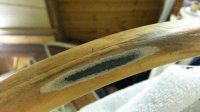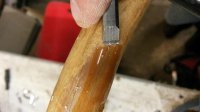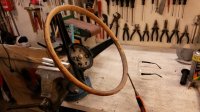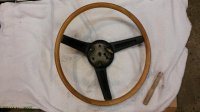My trick to get the old paint from a wooden steering wheel
Hi, just to add what worked best for me to get the old, cracked paint layer (appearently cellulose) from my steering wheel.
The best method I found to work well was use a chisel. The pointy end worked well to get the chips off that were already half detached, and the areas around it. It seems that humidity or so loosened the bond already there.
On the areas where the paint was still ok, it was tough, not brittle, so trying to chip it doesn't work. I used the side of a chisel for this; it has a clean, 90 degree steel edge. When scraping over the paint, it causes chips of the paint to fly of where it still brittle. In tougher paint it scrappes white curls from the paint . Best thing; the wood to stays ok if your carefull. (mind you it's just 1 millimeter thick in most places!)
I purchased for 30 dollar this used steering wheel, which showed a lot of cracks in the paint, filled with dirt and grease, and chips of paint already lost along its 40 year trip. The black spokes however were pretty OK, with only one small crack in the rear. I thought i'd give the wood a try, peel of the old paint and reapply. Worst thing that could happen is that I would damage the wood... I did.
I tried many things, amoung others paint remover. Indeed no go. sanding it of by hand gave me directly one huge 'sand through'. The wood layer is just 1 millimeter thick, and seems to be on a canvas carrier. So i'll likely follow the tip from this thread to use the wood dust to cover it up.
In the meantime i bought a second wheel, that's now also scraped and chipped clean. This one however has many cracks in the black spokes....
So ideally i'd like to combine the wood from one with the spokes from the other









